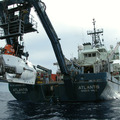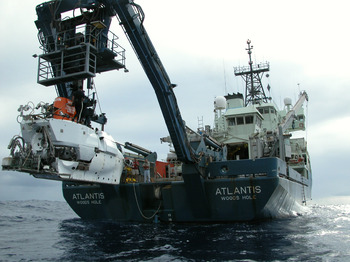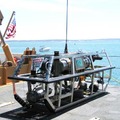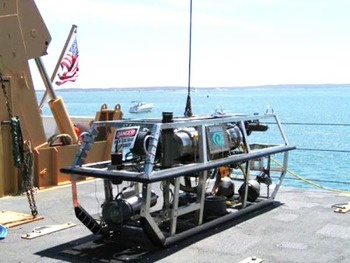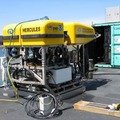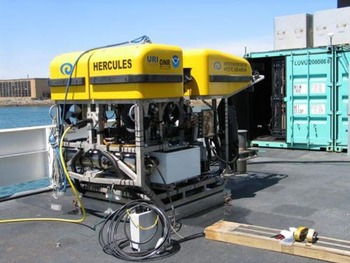Hercules is one of the very few Remotely Operated Vehicles (ROV) specifically designed to be used as a scientific tool. Built for the Institute For Exploration (IFE), Hercules is equipped with special features that allow it to perform intricate tasks while descending to depths of 4,000 meters (2.5 miles).
Although Hercules was designed primarily to study and recover artifacts from ancient shipwrecks, it is also well suited to study biology and geology in the deep sea. Along with a flexible set of tools that can be adjusted to specific requirements of each dive, Hercules also has a pair of manipulator arms attached to its front end. One of these arms is force-reflective, which means that the operator can feel the forces being applied to the arm through motors in the operator's master control unit.
Hercules carries an array of cameras and acoustic sensors that are used to gather video and other data during each dive. Most important, a High-Definition (HD) video camera allows scientists to closely examine the dive site and monitor operations using very high resolution video. A pair of still cameras can be used to accurately measure the depth and area of the research site, and to create "mosaics", large images built up from many smaller images. Other sensors measure pressure (which gives depth), water temperature, oxygen concentration, and salinity.
While Hercules was designed to support archaeology and other scientific missions, in many respects it is a fairly conventional "work class" ROV, very like those used to service oil rigs and underwater pipelines. It is comprised of an open aluminum frame that holds most of the components. A cylindrical titanium pressure case 12 inches in diameter and 52 inches long holds most of the vehicle's electronics. Hydraulic thrusters -- propellors in fixed ducts -- control the ROV's movements.
A bright yellow flotation package supports the rest of the vehicle when it is in the water, and drops the average density of Hercules to just a little less than the density of seawater. This makes Hercules just slightly buoyant, so it will float on the surface, but a small force generated by the vertical thrusters can drive the ROV up or down. The flotation package is made of "syntactic foam", composed of tiny, hollow glass balls mixed into epoxy resin. The foam is pretty heavy -- it has a density about half that of seawater -- but it can withstand the pressure exerted at a depth of 4,000 meters (more than 6,000 psi). The density of this foam is about the same density as pine or other softwood lumber.
Hercules had to be designed to withstand the enormous pressure at its maximum depth. Most of the vehicle's on-board electronics are built into cylindrical titanium pressure housings. Any air exposed to the outside pressure will be compressed to one four-hundredth of its original volume, which can destroy other components in the process. To avoid this, the vehicle's electrical components that are not in pressure housings are immersed in mineral oil, which does not compress significantly under pressure, and does not conduct electricity or cause corrosion like seawater. Electric motors, transformers, electrical junction boxes, and much of the external wiring are filled with oil. Hercules also uses the same oil, driven by a hydraulic pump, to activate its arms and thrusters.
Pilots aboard a support ship operate Hercules via a long fiber-optic cable that transmits operator commands, video, sensor data, and electrical power. The thrusters, commanded by the ROV pilot, move Hercules through the water. Like a helicopter, it can "fly" in any direction, but will gently float to the surface if its thrusters stop turning. Hercules is operated from a control room that is built into two standard 20-foot containers, so it can be moved onto different ships all over the world. The control room contains the computers, electronics, and video monitors which allow the ROV pilots to operate the vehicle.
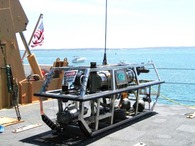 A Buddy System
A Buddy System
Hercules always operates in tandem with another vehicle, Argus. Referred to as a "tow sled", Argus dangles at the end of a cable from the ship. Because Argus lacks a buoyancy module and is built of heavy stainless steel, its movements are controlled by moving the ship or raising and lowering the cable. A short 30 meter (100 foot) tether connects Hercules to Argus, but it is usually kept slack so Hercules can move around without being pulled by the ship. Argus carries an HD video camera similar to the one on Hercules, as well as large lights that illuminate the area around Hercules. Argus allows the pilots and scientists to view Hercules' surroundings from above. Thrusters on Argus control its heading, so the pilots can aim the video cameras and lights toward Hercules and sites of interest.
Hercules generally operates 24 hours a day while at sea. To support this, teams of pilots and scientists (known as "watches") trade off operating the ROV and its systems so that others can eat, sleep, and do other work. There are six watch-standers on each watch. The Watch Leader makes sure that the scientific goals of the dive are being addressed. The Pilot operates Hercules, controlling its thrusters, manipulator arms, and other functions. The Engineer controls the winch that moves Argus up and down, as well as Argus' thrusters and other functions, and assists the Pilot. The Navigator monitors the work being done and the relative positions of the vehicles and ship and communicates with the ship’s crew to coordinate ship movements. Video and Data watch-standers record and document all the data that the vehicles send up from the deep.
For some missions, Hercules is replaced by Little Hercules, a much smaller, simpler ROV that is also capable of working at depths of 4,000 meters. Little Hercules has no arms or other tools, but gathers video images similar to those of Hercules.
Another exciting capability that IFE has developed is a system, based in a dedicated shipping container, that supports an antenna and electronics for transmitting data, including high resolution video, via satellite. The container can be placed aboard Hercules' support ship, and communicates with a shore-based facility. Upon receiving data and video, the onshore facility can distribute them almost anywhere. This enables scientists to actively participate in IFE missions without having to go to sea, and the experience can be shared in real time through educational programs. This capability allows a broad range of people -- from senior scientists to elementary school students -- to share in the excitement of underwater discovery as it is happening.
(text from http://oceanexplorer.noaa.gov/technology/subs/hercules/welcome.html)

